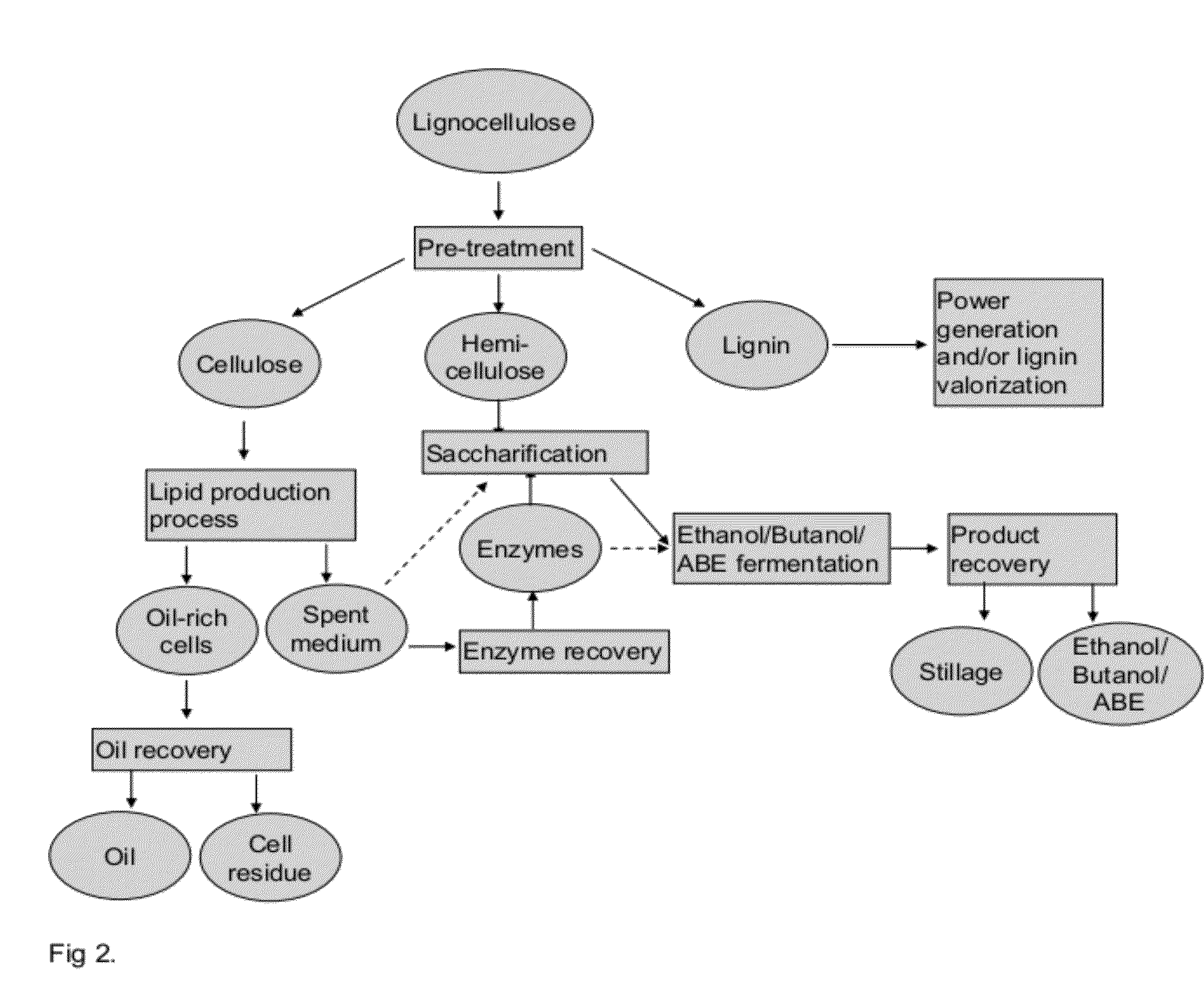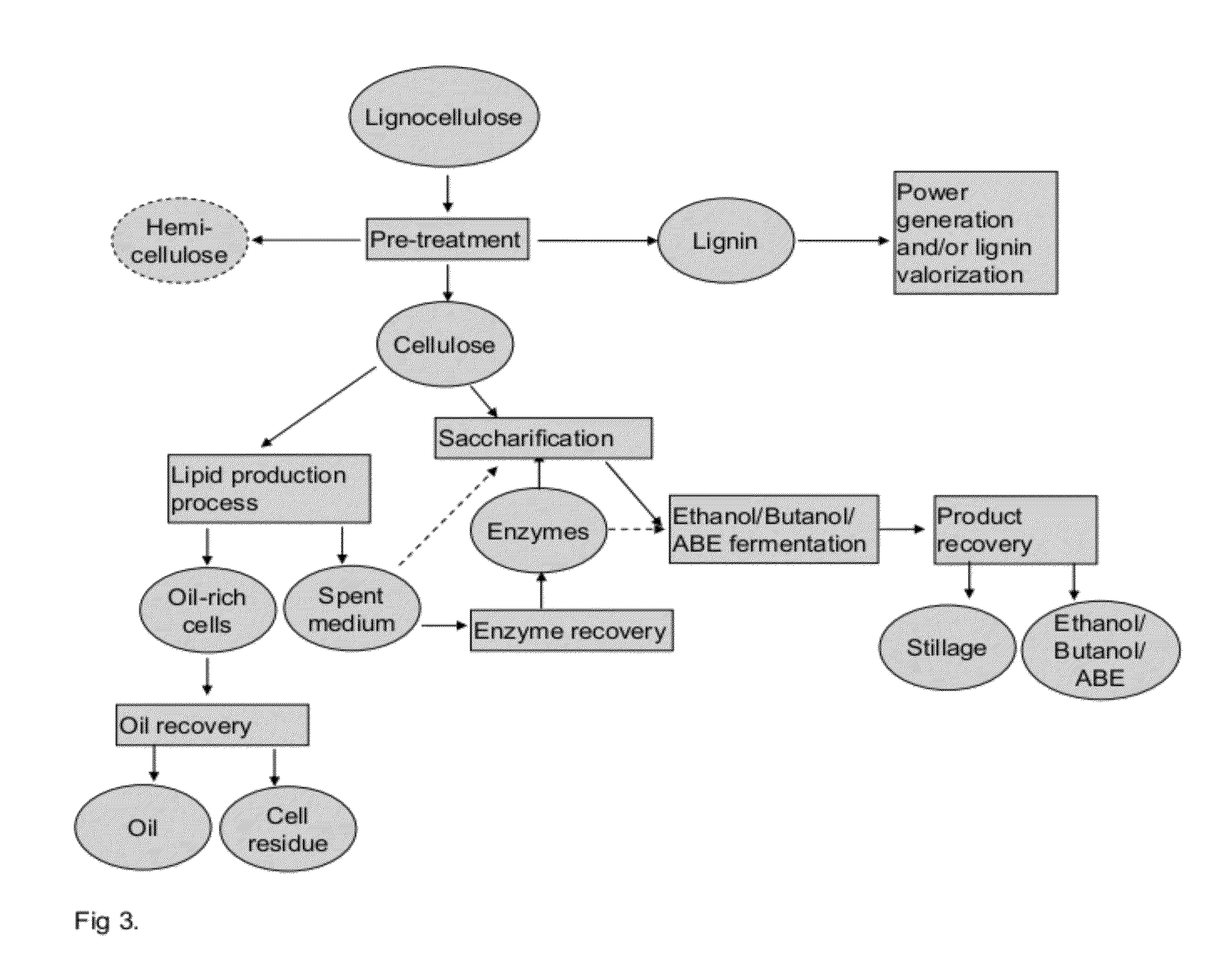Integrated Process for Producing Biofuels
a biofuel and integrated process technology, applied in the direction of enzymology, sustainable manufacturing/processing, bulk chemical production, etc., can solve the problems of complex lignocellulose material and resistance to biodegradation, inability to utilize pentose sugar, and inability to efficiently utilize total sugar in lignocellulose to ethanol
- Summary
- Abstract
- Description
- Claims
- Application Information
AI Technical Summary
Benefits of technology
Problems solved by technology
Method used
Image
Examples
example 1
[0283]This example shows the enzymatic activity formed in the culture broth during the cultivation of Aspergillus oryzae with cellulose based material as carbon source for the production of lipids.
[0284]Aspergillus oryzae was cultured for lipid production on different cellulose based lignocellulose materials. The growth medium base contained per liter of water 40 g lignocellulosic material as carbon source, 0.5 g yeast extract, 1 g MgSO4.7H2O, 0.5 g K2HPO4, 1 g KH2PO4 and 0.2 g CaCl2.2H2O and was supplemented with nitrogen source and trace metals.
[0285]Experiments 1-4 were performed as flask cultures. In experiments 1-3 the medium base was supplemented with 3 g NaNO3 and 0.02 g FeSO4.7H2O per liter and in experiment 4 the medium base was supplemented with 1 g (NH4)2SO4 per liter. Parallel cultivations were done in 250 ml Erlenmeyer flasks containing 50-100 ml culture medium. Cultivation media were inoculated with 1% (v / v) Aspergillus oryzae spore suspension. The cultures were incuba...
example 2
[0294]This example shows the enzymatic activity formed in the culture broth during the cultivation of Aspergillus terreus with hemicellulose based material as carbon source for the production of lipids.
[0295]Aspergillus terreus was cultivated for lipid production on a wheat straw hemicellulose as carbon substrate in 2 liter volume in a bioreactor. The culture medium comprised of 50 ml Yeast Nitrogen Base w / o Amino Acids and Ammonium sulphate (Difco) 10× stock solution suspended in 2 L water and supplemented with per liter: 1.0 g yeast extract, 1 g (NH4)2SO4, 1 g MgSO4.7H2O, 0.5 g K2HPO4, 1 g KH2PO4, 0.2 g CaCl2.2H2O and 2 g cellulose. The culture medium was inoculated with 150 ml 24 h precultured A. terreus culture. The fermentation was performed at 35° C. temperature with 3.0 l / min aeration and 200-430 rpm agitation. Culture pH was 5.7 and it was adjusted with 3 M NaOH during the cultivation. During the cultivation hemicellulose solution was fed to the fermentor. Enzyme activities ...
example 3
[0300]The example shows integration of ethanol production with lipid production. Ethanol is produced from cellulose hydrolysed by enzymes in spent culture medium obtained from lipid production by mould.
[0301]In Example 3 it was shown that spent culture medium from cultivation and lipid production of Aspergillus terreus on wheat straw hemicellulose supplemented with cellulose contain enzymes, xylanases and cellulases capable of hydrolysis of lignocellulosic materials.
[0302]The spent culture medium is in this cultivation used to hydrolyse cellulose. Pure cellulose or wheat straw cellulose is added to the spent culture medium, treated by ultrafiltration in an Amicon stirred ultrafiltration cell with a 10 000 Da filter (Millipore), from cultivation and lipid production of A. terreus on wheat straw hemicellulose supplemented with cellulose. The solution is incubated at 30-70° C. for 16-200 h for saccharification of cellulose. After saccharification, nutrients (NH4)2HPO4 (0.5 g / L), MgSO4....
PUM
| Property | Measurement | Unit |
|---|---|---|
| Catalytic activity | aaaaa | aaaaa |
Abstract
Description
Claims
Application Information
 Login to View More
Login to View More - R&D
- Intellectual Property
- Life Sciences
- Materials
- Tech Scout
- Unparalleled Data Quality
- Higher Quality Content
- 60% Fewer Hallucinations
Browse by: Latest US Patents, China's latest patents, Technical Efficacy Thesaurus, Application Domain, Technology Topic, Popular Technical Reports.
© 2025 PatSnap. All rights reserved.Legal|Privacy policy|Modern Slavery Act Transparency Statement|Sitemap|About US| Contact US: help@patsnap.com



